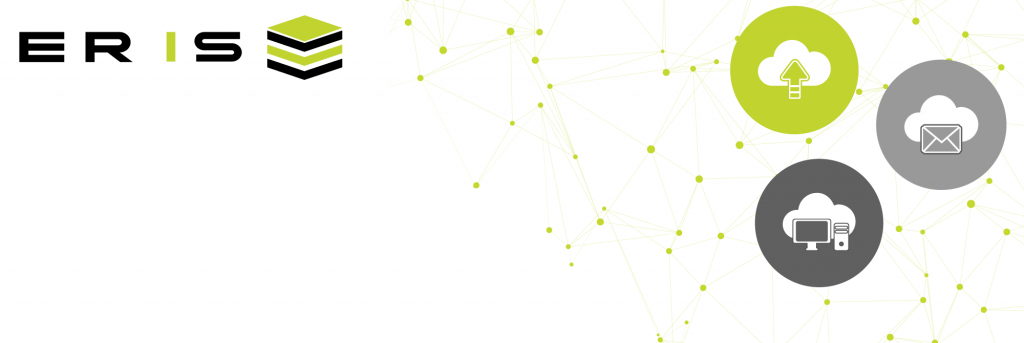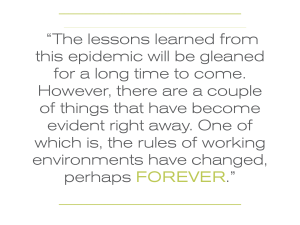The New Normal Working Environment

by Nate Gillette, AIA, LEED-Ap O+M, CEM
President of Natura Architectural Consulting, Grand Rapids, Michigan
Nate can be reached at [email protected]
April 30, 2020
Adjusting to the new normal during the COVID-19 health crisis has been a challenge for many consulting firms, both large and small. It seems that almost in an instant our lives got turned upside down with travel restrictions and stay at home orders being implemented without much time to prepare. Like most companies we are set up to work remotely with remote server access and cloud-based tools, but were we ready for something like this? Not even close.
Anyone involved in commercial real estate transactions routinely assesses a wide range of potential risks during environmental due diligence. It’s standard to evaluate historic and current property uses to identify contamination and other possible environmental liabilities. However, it’s vitally important to keep emerging issues on the radar, including new and unregulated risks that might not yet be “in scope” for routine environmental site assessments – and some of these emerging risk areas are poised to have a powerful impact on environmental due diligence.
A lot of our firm’s work revolves around the construction industry across the country. It has been a full-time job just keeping up with executive orders in each state and how the apply to construction. Here in Michigan where I live commercial construction is completely shut down and deemed non-essential. Many other states have carved out commercial or multifamily construction as essential, but with social distancing or other restrictions. There has been no consistency across the country and it’s difficult to keep up to frequently changing information.
 As a business owner, I feel torn between the inherent desire to reopen the economy and for business operations (i.e. billings and cashflow) to continue while ensuring the safety of my employees and their families. Both are extremely important….if we all get ill there’s no way to complete our work effectively to our high standards, but if we can’t operate and carry on business there will be no company to come back to in the end.
As a business owner, I feel torn between the inherent desire to reopen the economy and for business operations (i.e. billings and cashflow) to continue while ensuring the safety of my employees and their families. Both are extremely important….if we all get ill there’s no way to complete our work effectively to our high standards, but if we can’t operate and carry on business there will be no company to come back to in the end.
Often when faced with a crisis it is difficult to find the silver linings immediately. The lessons learned from this epidemic will be gleaned for a long time to come. However, there are a couple of things that have become evident right away. One of which is, the rules of working environments have changed, perhaps forever.
One of the biggest killers of innovation in a company is the notion of “this is the way we’ve always done things”. The COVID-19 crisis has forced us to rethink everything about how we operate as a company. It is sometimes said, a church isn’t a building it’s a community of people. I think we have started to bridge that gap with the traditional notion of an office. An office isn’t a building it’s a community of people working effectively together for a common good…regardless of location. With the advent of technology like Zoom and Microsoft Teams, we no longer need to be sitting in the same room to have a staff meeting. Construction meetings that we used to have to get on a plane and travel to all corners of the country a lot of times can be done virtually. The list goes on and on.
Is technology a complete replacement for the traditional notion of an office? Of course, it’s not. Sometimes it’s easier to poke your head around the corner at the office and ask someone a question than take the time to set up a zoom meeting…..but now we have more viable options. I say viable because for the last 3-5 weeks we have had to figure out how to make it work to continue operations. No ifs, ands, or buts…it had to work one way or another. Even the curmudgeons of technology in companies have been dragged into the new norm whether they wanted to be there or not.
For a few years now employers have experimented with the work at home model, but sometimes with an eye of suspicion. Is that employee really being productive? Can we trust them to get their work done without being under our watchful eye? Admittedly some employees just do not thrive well in that kind of environment. They need a higher level of accountability and crave a higher level of human contact. That’s fine – everyone has a different environment where they are most productive. But having the option of viable traditional and non-traditional working environments is a game-changer.
It will be interesting to see the technological innovations that will continue to be inspired by our current struggle and how they will change our working environments for the good. Implications of higher productivity, reduced travel costs, healthier and happier employees, and better work-life balance are not hard to imagine and very well may become more achievable.

